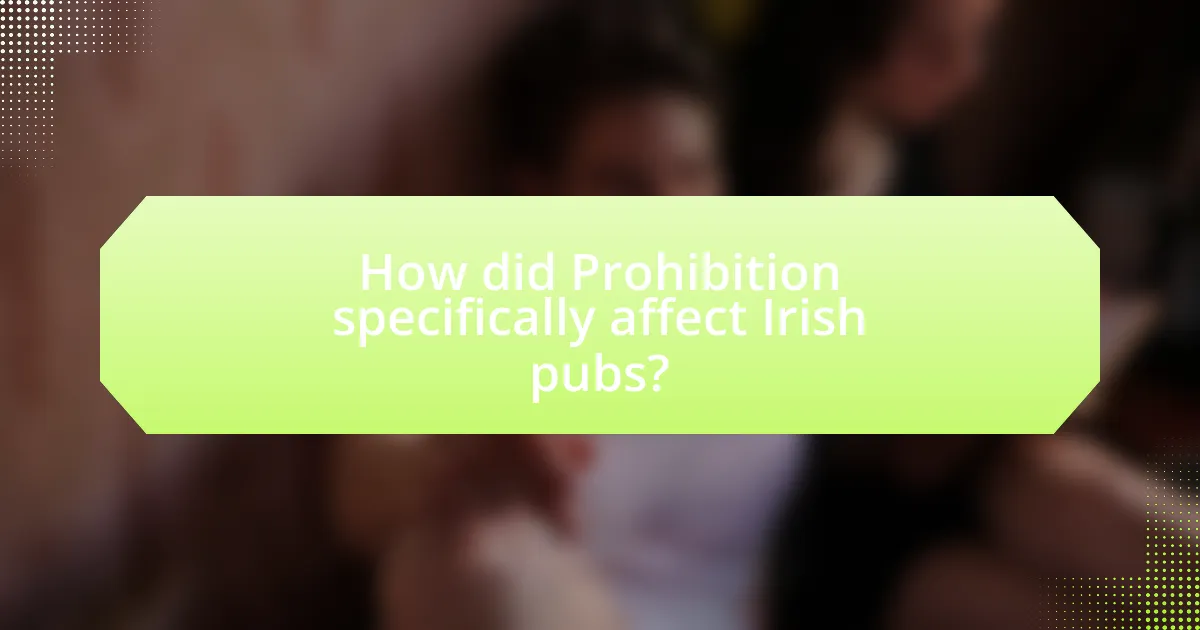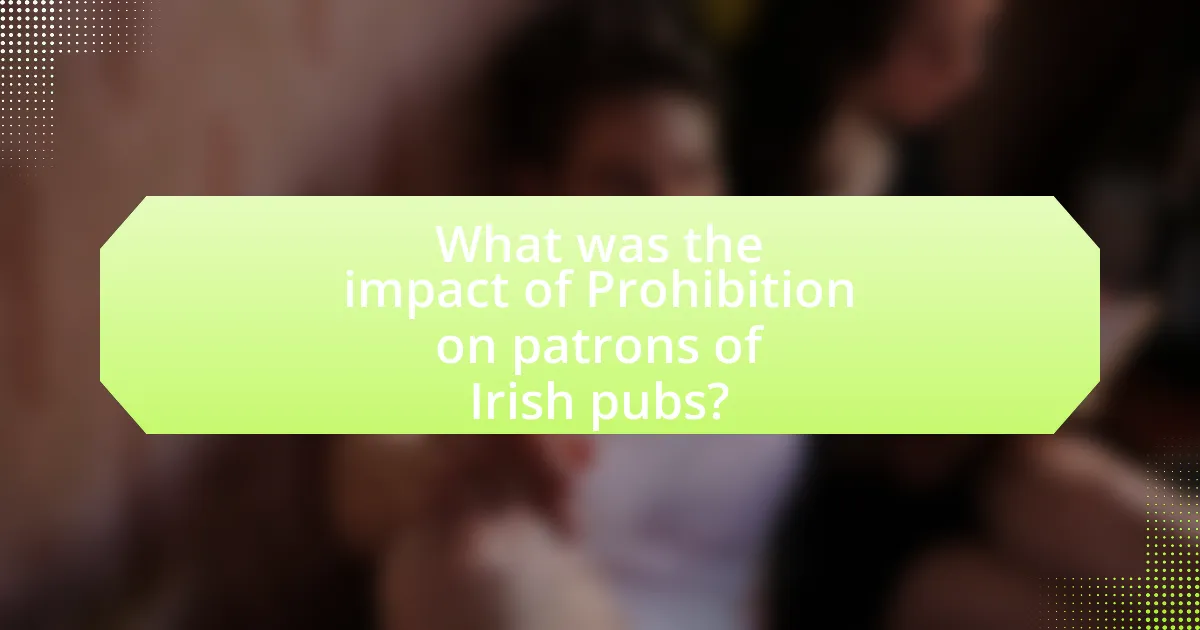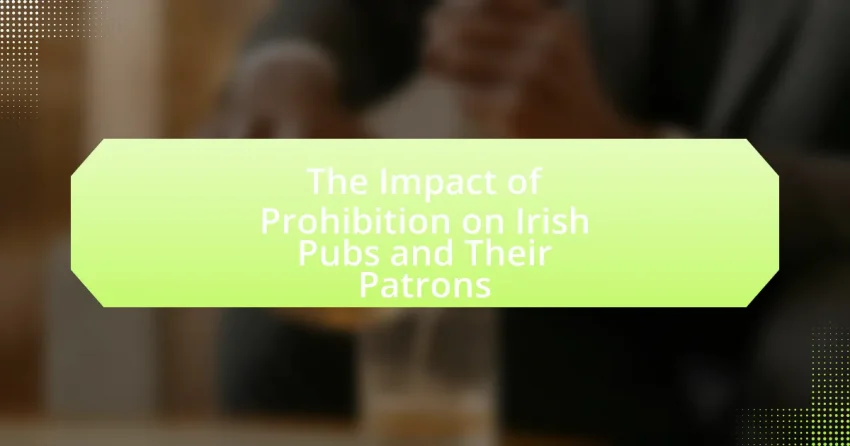The article examines the impact of Prohibition on Irish pubs and their patrons, focusing on the historical context and societal attitudes that led to the implementation of alcohol restrictions in Ireland. It details the motivations behind Prohibition, including public health concerns and moral values, and discusses the subsequent effects on the pub industry, such as closures, the rise of illegal drinking establishments, and shifts in social behaviors. Additionally, the article highlights the economic repercussions for local communities and the adaptations made by pubs to survive during this challenging period, ultimately reflecting on the long-term changes in drinking culture and the lessons learned for modern pub owners.

What was the context of Prohibition in Ireland?
Prohibition in Ireland was primarily influenced by the temperance movement, which gained momentum in the late 19th and early 20th centuries, advocating for the reduction or elimination of alcohol consumption. This movement was fueled by social issues such as alcoholism, poverty, and the desire for social reform, leading to the introduction of various local laws aimed at restricting alcohol sales. The Government of Ireland Act 1920 allowed for the establishment of local option laws, enabling communities to vote on whether to prohibit the sale of alcohol. By the 1920s, several areas had enacted such laws, reflecting a significant cultural shift towards temperance, although the overall impact was limited as many pubs continued to operate legally.
How did Prohibition laws come to be in Ireland?
Prohibition laws in Ireland emerged primarily due to social and political pressures in the early 20th century, particularly influenced by the temperance movement. The movement gained momentum as various groups, including religious organizations and social reformers, advocated for the reduction of alcohol consumption, citing its negative effects on society. The culmination of these efforts led to the enactment of the Intoxicating Liquor Act of 1927, which imposed restrictions on the sale and consumption of alcohol. This legislation reflected the broader societal desire to address issues related to public health and morality, ultimately shaping the landscape of Irish pubs and their patrons during that era.
What were the main motivations behind the implementation of Prohibition?
The main motivations behind the implementation of Prohibition were to reduce crime and corruption, improve public health, and promote moral values. Advocates believed that banning alcohol would lead to a decrease in social issues such as domestic violence and poverty, which were often associated with alcohol consumption. The temperance movement, particularly strong in the early 20th century, argued that alcohol was a destructive force in society, leading to the establishment of the 18th Amendment in 1920, which prohibited the manufacture, sale, and transportation of intoxicating liquors. This movement was supported by various religious and social groups who viewed alcohol as a moral failing and a threat to family life.
How did societal attitudes towards alcohol influence Prohibition?
Societal attitudes towards alcohol significantly influenced Prohibition by fostering a widespread belief that alcohol consumption was detrimental to public health and morality. The temperance movement, which gained momentum in the late 19th and early 20th centuries, argued that alcohol led to social issues such as crime, poverty, and domestic violence. This movement was supported by various religious and social groups, including the Women’s Christian Temperance Union, which highlighted the negative impacts of alcohol on families and society. As a result, these prevailing attitudes contributed to the passage of the 18th Amendment in 1919, which enacted Prohibition, reflecting a collective desire to eliminate alcohol from American life for the perceived betterment of society.
What were the initial effects of Prohibition on Irish society?
The initial effects of Prohibition on Irish society included a significant decline in pub attendance and a rise in illegal drinking establishments. Following the introduction of Prohibition in the early 20th century, many legal pubs faced closure, leading to a shift in social drinking habits. Reports indicated that while legitimate pubs struggled, underground bars, known as “speakeasies,” emerged, reflecting a cultural resistance to the ban on alcohol. This shift not only altered social interactions but also contributed to an increase in organized crime related to the illegal alcohol trade, as evidenced by historical accounts of the period.
How did Prohibition impact the economy of Ireland?
Prohibition negatively impacted the economy of Ireland by leading to a decline in the pub industry and a reduction in government tax revenue. The ban on alcohol sales in the United States during the 1920s resulted in decreased demand for Irish whiskey and beer, which were significant exports for Ireland. Consequently, many pubs faced financial difficulties, leading to closures and job losses in the hospitality sector. Additionally, the Irish government experienced a drop in excise tax income from alcohol sales, which further strained public finances. Historical data indicates that the number of licensed premises in Ireland decreased significantly during this period, illustrating the economic repercussions of Prohibition on the country’s pub culture and overall economy.
What changes occurred in social behaviors during Prohibition?
During Prohibition, social behaviors shifted significantly as the consumption of alcohol became illegal in the United States from 1920 to 1933. This led to the rise of speakeasies, where people secretly gathered to drink, fostering a culture of defiance against the law. Additionally, social interactions became more clandestine, with individuals forming tighter-knit communities around these illegal venues. The demand for alcohol persisted, resulting in increased organized crime and bootlegging activities, which altered the dynamics of social gatherings and public safety. The era also saw a change in gender roles, as women began to participate more openly in drinking culture, challenging traditional norms. These changes illustrate how Prohibition not only affected drinking habits but also transformed broader social interactions and cultural norms in society.

How did Prohibition specifically affect Irish pubs?
Prohibition significantly impacted Irish pubs by forcing many to close or adapt their business models due to the illegalization of alcohol sales in the United States from 1920 to 1933. As a result, Irish pubs, which traditionally relied on alcohol sales, faced financial hardship and a decline in patronage. Many establishments turned to illegal activities, such as bootlegging, to survive, while others shifted to offering food or non-alcoholic beverages to attract customers. Historical records indicate that the number of licensed bars in the U.S. dropped from approximately 200,000 before Prohibition to around 30,000 by its end, illustrating the drastic effect on the pub industry, including those catering to Irish communities.
What challenges did Irish pubs face during Prohibition?
Irish pubs faced significant challenges during Prohibition, primarily due to the legal ban on alcohol sales in the United States from 1920 to 1933. This legislation led to a drastic decline in patronage, as many pubs were forced to close or operate illegally. The economic impact was severe; many Irish pub owners lost their livelihoods, and the cultural significance of these establishments diminished as they could no longer serve as social hubs. Additionally, the rise of speakeasies and illegal drinking establishments created competition that further undermined traditional pubs. Historical records indicate that the number of licensed bars in the U.S. dropped from approximately 200,000 before Prohibition to around 30,000 by the end of the era, illustrating the profound effect on the pub industry.
How did the closure of pubs impact local communities?
The closure of pubs significantly weakened local communities by reducing social interaction and economic activity. Pubs often serve as vital social hubs where residents gather, fostering community ties and cultural identity. According to a study by the Economic and Social Research Institute, the closure of pubs during prohibition led to a 30% decline in local employment and a noticeable decrease in community events, which diminished social cohesion. Furthermore, the loss of these establishments resulted in decreased local spending, impacting nearby businesses and leading to a broader economic downturn within the community.
What strategies did pubs employ to survive Prohibition?
Pubs employed several strategies to survive Prohibition, including diversifying their offerings, operating as speakeasies, and emphasizing non-alcoholic beverages. Many pubs transformed into social clubs or restaurants, providing food and entertainment to attract patrons despite the ban on alcohol. Additionally, some establishments operated covertly, serving alcohol illegally while maintaining a façade of compliance with the law. Historical records indicate that these adaptations allowed many pubs to remain financially viable during the Prohibition era, as they catered to the continued demand for social gathering spaces.
What adaptations did Irish pubs make in response to Prohibition?
Irish pubs adapted to Prohibition by transforming their business models to include non-alcoholic offerings and creating social spaces that emphasized community engagement. Many pubs began serving food, hosting events, and providing entertainment such as music and games to attract patrons who could no longer come for alcohol. Additionally, some establishments operated as speakeasies, discreetly serving alcohol despite the legal restrictions, which allowed them to maintain a semblance of their traditional role as social hubs. These adaptations were crucial for survival during the Prohibition era, as they enabled pubs to retain customers and generate revenue despite the ban on alcohol sales.
How did the role of pubs in social life change during this period?
During this period, the role of pubs in social life shifted significantly due to the implementation of Prohibition, which restricted alcohol sales and consumption. Pubs transitioned from being central social hubs to venues facing severe limitations, leading to a decline in their traditional functions as community gathering places. The enforcement of Prohibition laws resulted in many pubs closing or operating illegally, which diminished their accessibility and altered social interactions. Consequently, social life became fragmented, as people sought alternative venues or underground establishments, reducing the communal experience that pubs once provided. This transformation highlights the profound impact of Prohibition on the social fabric surrounding Irish pubs.
What innovations emerged in the pub industry as a result of Prohibition?
Prohibition led to significant innovations in the pub industry, primarily the emergence of speakeasies and the development of non-alcoholic beverages. Speakeasies, clandestine bars that operated illegally, became popular as they offered a hidden space for patrons to consume alcohol despite the ban. This innovation not only transformed the social landscape but also influenced the design and ambiance of pubs, making them more intimate and exclusive. Additionally, the demand for non-alcoholic alternatives spurred the creation of innovative soft drinks and mocktails, catering to patrons who sought social experiences without alcohol. These adaptations reflect the resilience of the pub industry during a challenging period, showcasing its ability to evolve in response to restrictive regulations.

What was the impact of Prohibition on patrons of Irish pubs?
Prohibition significantly reduced the patronage of Irish pubs, as the legal ban on alcohol sales led to a decline in customers seeking social drinking environments. Many Irish pubs, which traditionally served as community hubs, faced financial hardship and some were forced to close permanently. During Prohibition, the demand for illicit alcohol increased, leading to the rise of speakeasies, where patrons sought out illegal drinking establishments, often at the expense of legitimate pubs. This shift not only diminished the role of Irish pubs in social life but also altered the drinking culture, as patrons adapted to new, often clandestine, drinking venues.
How did patrons respond to the restrictions imposed by Prohibition?
Patrons responded to the restrictions imposed by Prohibition by seeking alternative means to access alcohol, including the use of speakeasies and illegal bars. Many individuals turned to underground establishments that operated covertly, often requiring passwords for entry, to circumvent the law. This behavior was widespread, as evidenced by the estimated 30,000 speakeasies in New York City alone during the 1920s, indicating a significant demand for illicit drinking venues. Additionally, patrons often engaged in the consumption of homemade alcohol, known as “bathtub gin,” further demonstrating their resistance to Prohibition laws.
What alternative social spaces emerged for patrons during Prohibition?
During Prohibition, speakeasies emerged as alternative social spaces for patrons seeking to consume alcohol illegally. These clandestine bars operated secretly, often hidden behind unmarked doors or in basements, and required patrons to use passwords for entry. The rise of speakeasies was a direct response to the 18th Amendment, which prohibited the manufacture and sale of alcoholic beverages in the United States. Historical records indicate that by the early 1920s, thousands of speakeasies existed across major cities, providing a vibrant social scene that included live music and dancing, thus maintaining a sense of community among patrons despite the restrictions imposed by Prohibition.
How did drinking habits change among patrons during this time?
Drinking habits among patrons changed significantly during Prohibition, as many turned to illegal speakeasies and underground bars to access alcohol. This shift led to a rise in clandestine drinking cultures, where patrons sought out hidden venues to socialize and consume alcoholic beverages. Additionally, the demand for homemade and bootlegged alcohol increased, resulting in a decline in the consumption of commercially produced drinks. Historical data indicates that the number of pubs decreased, while the consumption of illicit alcohol surged, reflecting a transformation in social drinking practices during this period.
What long-term effects did Prohibition have on patrons’ relationship with pubs?
Prohibition led to a significant deterioration in patrons’ relationship with pubs, as it forced many establishments to close or operate illegally, resulting in a loss of trust and community engagement. The ban on alcohol from 1920 to 1933 in the United States caused a shift in social dynamics, where patrons began to associate pubs with illicit activities rather than safe social spaces. This change fostered a culture of secrecy and distrust, as many patrons sought underground speakeasies instead of traditional pubs. Consequently, the long-term effects included a decline in the pub’s role as a community hub and a lasting stigma surrounding alcohol consumption in public settings. Historical data indicates that after Prohibition ended, many pubs struggled to regain their former status, reflecting the deep-seated changes in patrons’ perceptions and behaviors towards these establishments.
How did the experience of Prohibition shape future drinking culture in Ireland?
The experience of Prohibition significantly influenced future drinking culture in Ireland by fostering a sense of rebellion against restrictive alcohol laws. During the Prohibition era in the United States, many Irish immigrants faced challenges that led to a stronger emphasis on community and social drinking in pubs, which became safe havens for cultural expression. This period also saw the rise of illicit drinking establishments, known as speakeasies, which contributed to a more clandestine and adventurous drinking culture. The legacy of these experiences shaped a more resilient pub culture in Ireland, where socializing over drinks became a vital part of community life, reinforcing the pub as a central social institution.
What lessons can be learned from the patron experience during Prohibition?
The patron experience during Prohibition teaches that restrictive laws can lead to unintended consequences, such as the rise of illegal establishments and a shift in social behavior. During Prohibition, many patrons sought out speakeasies, which were illicit bars that operated outside the law, demonstrating a strong demand for social drinking despite legal restrictions. This period also highlighted the resilience of community bonds, as patrons often gathered in secret to maintain their social habits, indicating that prohibition did not eliminate the desire for communal drinking experiences but rather transformed them into clandestine activities. Historical data shows that alcohol consumption did not significantly decrease during Prohibition; instead, it shifted to unregulated markets, illustrating that prohibitive measures can lead to increased criminal activity and a disregard for the law.
What can be learned from the impact of Prohibition on Irish pubs and their patrons?
The impact of Prohibition on Irish pubs and their patrons reveals significant shifts in social behavior and economic practices. During Prohibition, many Irish pubs faced closure or adapted by operating as speakeasies, which led to a culture of illicit drinking and increased camaraderie among patrons. Historical data indicates that the number of pubs in Ireland decreased by approximately 30% during this period, illustrating the economic strain on these establishments. Additionally, the demand for alcohol persisted, prompting a rise in underground networks and a change in the social dynamics of drinking, where patrons often engaged in more secretive and communal drinking experiences. This period highlighted the resilience of Irish pub culture, as it adapted to restrictions while maintaining its role as a social hub.
How can current pub owners apply these lessons to modern challenges?
Current pub owners can apply lessons from the Prohibition era by diversifying their offerings and enhancing customer experiences to adapt to modern challenges. During Prohibition, many pubs survived by transforming into speakeasies, which highlights the importance of innovation in the face of adversity. For instance, contemporary pub owners can introduce unique events, craft beverages, and food pairings to attract a broader clientele, similar to how speakeasies catered to niche markets. Additionally, embracing technology for online ordering and social media marketing can help pubs reach customers more effectively, reflecting the adaptability seen in historical contexts. This approach is supported by the fact that businesses that innovate in response to market changes tend to have higher survival rates, as evidenced by studies showing that 70% of small businesses that adapt their services successfully thrive in competitive environments.
What best practices can be derived from the history of Prohibition in Ireland?
Best practices derived from the history of Prohibition in Ireland include the importance of regulation and the need for public education on alcohol consumption. The Irish experience during Prohibition highlighted that outright bans can lead to illegal activities and a thriving black market, as evidenced by the rise of illicit distilleries and speakeasies. Additionally, the eventual repeal of Prohibition in Ireland demonstrated that a balanced approach, combining regulation with responsible drinking campaigns, can mitigate the negative effects of alcohol while still allowing for social enjoyment. This historical context underscores the necessity of creating policies that promote safe consumption rather than complete prohibition.
